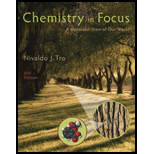
Interpretation:
The functioning of the methods carbon filtration, water softening and reverse osmosis used for home treatment is to be explained, and the impurities they remove are to be determined.
Concept Introduction:
Water is a common liquid that is present on the Earth.
It is also known as universal solvent. It can dissolve a wide range of organic and inorganic solutes.
Water is vital for the existence of all living animals. Without water, no life form can exist, it constitutes an important part of rivers, lakes, streams, clouds, snow and ice.
Water is truly an unusual molecule such that being a low molar mass compound, it exists as a liquid at room temperature and has an anonymously high boiling point.
Ice floats on water because it has a lower density than water.
Water contains some unwanted particles which can lead to diseases and other hostile effects on human health.
Numerous particles and microbes, such as bacteria can contaminate the water.
Biological contaminants: Some microbes can live in water and can cause various diseases like cholera, dysentery, and so on. Two examples of such microbes are Giardia and Legionella.
Inorganic contaminants: Some inorganic molecules can dissolve in water and make it impotable (not suited for drinking). Two examples of such molecules are Nitrates and Asbestos.
Organic contaminants: Some organic molecules can dissolve in water and makes it impotable (not suited for drinking). Two examples of such molecules are chlorohydrocarbons (volatile) and ethylbenzene (non-volatile).
Radioactive contaminants: Some radioactive elements can dissolve in water and make it impotable (not suited for drinking). Two examples of such elements are Uranium and Radium.
Contaminants that pose immediate health risks are the biological contaminants and inorganic contaminants because they get immediately dissolved in blood and starts reacting with it.
Contaminants that can be eliminated by boiling are the biological contaminants because the microbes can be killed by increasing the temperature.
Drinking water is made safe by using some techniques such as filtration, sedimentation and so on.
Drinking water is also made safer at homes by using carbon filtration, water softening and reverse osmosis.
Ground water contains salts of magnesium and calcium, and is also known as hard water.
Hard water prevents the action of soap and cannot be used for cleansing actions.
Want to see the full answer?
Check out a sample textbook solution
Chapter 12 Solutions
Chemistry In Focus
- n oil spill spreads out on the surface of water, rather than dissolving in the water. Explain why.arrow_forwardHow much CaCl2 , in grams, is needed to make 2.0 L ofa 3.5M solution?arrow_forward28. Use your model above to try to explain why liquids like mineral oil or acetone are notgood at dissolving salts, or why mineral oil and acetone molecules do not stick together aswell as water molecules.arrow_forward
- While preparing lunch, the recipe book told you to dissolve half a teaspoon of cornstarch in a 500 mL of cold water. How do you classify this starch-water combination? a. Colloidal system b. True solution c. Suspension d. Emulsifying agentarrow_forwardList three physical properties of tap water: a.______________________ b.______________________ c.______________________arrow_forward

 Chemistry for Today: General, Organic, and Bioche...ChemistryISBN:9781305960060Author:Spencer L. Seager, Michael R. Slabaugh, Maren S. HansenPublisher:Cengage Learning
Chemistry for Today: General, Organic, and Bioche...ChemistryISBN:9781305960060Author:Spencer L. Seager, Michael R. Slabaugh, Maren S. HansenPublisher:Cengage Learning Introductory Chemistry: A FoundationChemistryISBN:9781337399425Author:Steven S. Zumdahl, Donald J. DeCostePublisher:Cengage LearningChemistry: Matter and ChangeChemistryISBN:9780078746376Author:Dinah Zike, Laurel Dingrando, Nicholas Hainen, Cheryl WistromPublisher:Glencoe/McGraw-Hill School Pub Co
Introductory Chemistry: A FoundationChemistryISBN:9781337399425Author:Steven S. Zumdahl, Donald J. DeCostePublisher:Cengage LearningChemistry: Matter and ChangeChemistryISBN:9780078746376Author:Dinah Zike, Laurel Dingrando, Nicholas Hainen, Cheryl WistromPublisher:Glencoe/McGraw-Hill School Pub Co Chemistry: The Molecular ScienceChemistryISBN:9781285199047Author:John W. Moore, Conrad L. StanitskiPublisher:Cengage Learning
Chemistry: The Molecular ScienceChemistryISBN:9781285199047Author:John W. Moore, Conrad L. StanitskiPublisher:Cengage Learning





